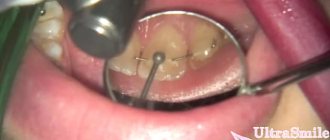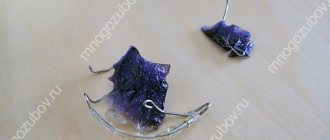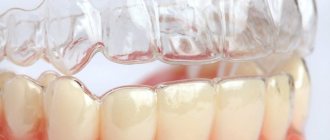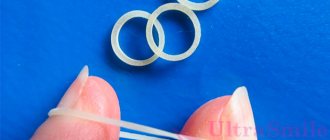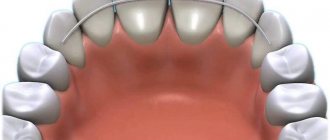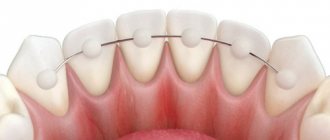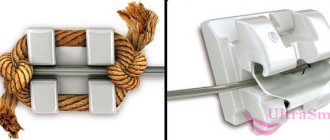Correcting a bite is a complex and lengthy process that requires a lot of patience. But not everyone knows that treatment does not end with wearing braces. The fact is that the design of brace systems requires a fairly quick correction of the patient’s tooth position, but it cannot guarantee the stability of the result. This is due to the structure of the jaw and other natural factors. To consolidate progress after braces, a retainer is installed and left for the required period.
About retention, the mechanisms of its occurrence and consequences, read the article: What are impacted teeth, why do they appear and how to treat them...
What are they and for what purposes are they installed?
What are retainers after braces ? This is the name of a type of orthodontic splint that is worn during the retention period. This is the time when the tooth tends to return to its original position. The retainer prevents curvature until the bite becomes permanent.
A return to the incorrect position of the teeth in the mouth occurs due to the peculiarities of their structure. The fact is that in addition to the usual position, the tooth has a ligamentous apparatus. The ligaments are much more conservative than the bite itself; they strive to return everything to the way it was. It takes a lot of time to retrain ligaments and muscles. Orthodontic retainers help fight muscle memory, which tends to ruin your teeth again.
Until recently, doctors believed that after correcting the bite, teeth remain straight for life. Today it has been proven that this is a myth.
Do mouthguards help straighten teeth?
In search of a means to correct dentition, many people wonder whether straightening teeth with mouth guards will bring the expected effect. Their fears are related precisely to the wrong choice of caps, which does not lead to the expected result. Remember: only specially designed mouth guards made according to your impression right in the clinic are suitable for correcting your bite and straightening your teeth. Sports masks, whitening or remineralizing masks are not intended for this! In addition, there are a number of rules that must be followed when wearing a mouthguard, otherwise you will not benefit from all their benefits.
Types of designs and their differences
There are several types of retainers for teeth after braces . It is better to choose the most suitable one together with your doctor. Devices can be classified by size and type of material, but the classic basis for dividing products into groups is the ability to independently remove the simulator. So, there are fixed and removable retainers . Each type has its own characteristics and advantages.
Fixed retainers
Models that cannot be removed are more popular, so first you should understand what it is - a non-removable retainer . The device is a small fixing wire that is attached to the inside of the teeth. It is installed by the doctor immediately after the braces are removed.
The non-removable structure is almost impossible to see
There have been many studies on the effect of wire on teeth . Most dentists agree that the product is absolutely safe for enamel. It is attached with a special composite material and practically does not interfere with the patient.
On average, after the installation of retainers , a week must pass for the patient to stop noticing them. The only inconvenience he faces is the need for more thorough brushing of his teeth. While wearing it, it is recommended to use a special irrigator with an attachment that provides more thorough oral care.
Removable structures
A removable retainer is also called a “retention mouth guard.” At its core, the device is the same aligner with a metal arch, which does not need to affect the bite. Unlike removable systems, such systems require diligence and pedantry from the patient: it is necessary to strictly follow the doctor’s instructions, wear the products for the prescribed time, day and night.
Often, a removable retainer becomes an addition to a fixed model. Then it is worn overnight and removed for the day, but the wire remains on the teeth for 24 hours. Such measures are necessary if the doctor notices very strong bite resistance or if the wire is not effective enough for some molars or incisors.
Removable retainers are easy to put on but still noticeable on the teeth.
There are two types of removable retainers after braces :
- for both jaws. They are usually prescribed to be worn during the night, since such designs do not allow talking or drinking;
- retainers on the upper jaw or lower jaw - as necessary. Such models can be prescribed instead of a non-removable device, then they will have to be worn more often.
If non-removable models require the patient to spend time thoroughly cleaning the oral cavity, then when wearing removable ones, you may notice that this dental retainer requires more attention and care. It is advisable to regularly rinse and clean it according to the manufacturer’s instructions.
Another type of removable retainer. It is used less often, because hard elements harm the teeth and are very noticeable.
In some cases, the doctor gives preference to newer means - trainers. Read more about them in a separate article: Trainers for teeth straightening: description, varieties, tips for use...
Kinds
Mouth guards for correcting bites are classified according to:
- manufacturing technologies;
- material;
- wearing time;
- patient's age.
According to manufacturing technology:
- Individual - the most reliable and convenient type of mouthguards
Standard. They are created according to a single pattern and are more often used for teeth whitening. They do not take into account the bite characteristics of a particular person and can create discomfort when worn.
- Thermoplastic. Made from a material that softens and becomes elastic when heated. The mouthguard is placed in hot water, and then placed on the teeth until it cools completely and, if necessary, is further adjusted.
- Individual. The most reliable and convenient type of cap. The device is made based on a cast of the patient's jaw.
By wearing time:
- 24 hours a day. They are removed only when eating or brushing your teeth. Placed to correct severe bite defects.
- Nighttime. Only worn at night. They are used for minor malocclusions or in the last stages of the retention period.
Mouth guards are made from bioplastic or silicone. There is practically no difference between these two materials; they are both hypoallergenic, transparent, almost imperceptible on the teeth and do not injure the oral cavity. Adult and children's mouth guards differ in size and, in addition, a children's mouth guard is very easy to remove.
What are the pros and cons
The pros and cons of retainers after braces are removed depend on the type of design used. The general advantages are the consolidation of the treatment result, after which the doctor can guarantee that the teeth will remain straight for many years.
Advantages and disadvantages of fixed models
The main advantages of models that are permanently attached to the bite are:
- constant impact on the tooth, reducing the risk of reducing the effectiveness of procedures;
- absence of unpleasant sensations during the installation of retainers and their subsequent wearing;
- quick adaptation to the product (some get used to it immediately, others within a week);
- absence of external signs of the presence of a dental retainer , which is especially important for patients who need to work with people.
Patients who use such models say that a non-removable retainer is a tool that creates inconvenience only at first. Brushing your teeth is a little difficult at first, but compared to cleaning your teeth while wearing braces, it's nothing. Also considered disadvantages are the need to visit the dentist and periodic damage to the wire, due to which it is necessary to organize an unscheduled visit to the doctor.
Many people choose non-removable models, because such a retainer is not visible in the photo and it does not interfere with the smile. If you don't tell the person you're wearing a device, no one will know about it.
Advantages and disadvantages of removable models
The removable retainer gets a lot of good reviews thanks to the following advantages:
- you don’t need to wear it all the time, you can put it on only at night (the timing and regularity of wearing it depend on your doctor’s recommendations);
- allows you to get a break from the presence of hard structures in the mouth after treatment with braces;
- Easy to clean with a special brush and paste.
The main disadvantage of the appliance is that it is a visible dental retainer . During the day, when the plate is in the mouth, it significantly changes the appearance of the smile. This can cause complexes and inconveniences. Also, for some, the design leads to increased salivation, which is quite inconvenient.
There are cases when a doctor prescribes the installation of two types of retainers at once: a fixed structure on one jaw and wearing a mouthguard on the other.
The importance of a retainer in the fight for straight teeth
Muscle memory is long and strong, and it takes a lot of effort to direct it in a different direction. Retainers are needed so that muscles, bone tissue, and ligaments become accustomed to the physiologically correct position. The participation of the patient is important: follow all the doctor’s recommendations, wear removable retainers for the time prescribed by the doctor, and clean non-removable ones. Anyone who completes treatment will receive a lasting positive result. For those who have gone through a long period of treatment with braces, using retainers will not seem difficult.
Parents are required to help their child follow all the dentist’s instructions. A significant amount of money was paid for the treatment, the most difficult stage is over, now there is no need to stop there. The main task is to consolidate the result and smile. Consistency is important when using removable retainers, but it pays off in the end result. The patient already sees his straight teeth, this is the greatest motivation to make further efforts.
How does the installation process work?
A retainer after braces is placed in the doctor's office. The process takes place in several stages:
- Preparation of the oral cavity. First you need to make sure that years of wearing braces have not damaged the enamel. The doctor also checks for the presence of caries, removes plaque, and applies a protective layer to the enamel;
- Manufacturing of a retention apparatus. Since retainers are placed on specific teeth, they are usually made specifically for the patient.
- The wire-tire is fixed with special composite materials.
In the video below you can see how retainers are installed using the indirect fixation method.
If we are talking about a mouthguard, you can put it on yourself. But usually the doctor controls the process, because this helps to adjust the dental retainer to the shape of the jaw. There are models that are made to order, and there are thermally modeled ones that can be adjusted to the bite after heating.
How long will you have to wear the structure?
Only a doctor can tell you how long to wear retainers For one person a year is enough, for another it will take several years. You can only estimate approximate times: to do this, multiply the time you spent with the bite correction system by two. The average is from 3 to 6 years, but everything is very individual.
There are exceptions in which there are no strict terms for wearing a retainer after braces . If the process of muscle training is very slow, you will have to walk with the plate all your life.
How does the withdrawal process work?
The aligners are easily removed from the teeth and must be removed from the mouth for morning and evening care. But a non-removable retainer will have to be removed by a doctor after the braces are removed . But don't rush into this decision. If the product does not bother you, continue wearing it.
Is it possible to remove the wire yourself?
The composite material on which the tape is attached sometimes flies off on its own. Therefore, in theory, the device can be removed independently. But you need to understand that removing a dental retainer without a doctor is a big risk. You can damage the enamel and tooth. Just ask your orthodontist for help, and he will remove the wire in a few minutes.
Frequently asked questions about wearing retainers
Retainers are a popular product many people wear after braces Therefore, many questions arise about him. The DENT-HUNTER team has prepared answers to the most important of them. If we didn't take something into account, ask questions in the comments.
How to brush your teeth with a permanent retainer?
With retainers, after removing braces, you need to pay maximum attention to brushing your teeth. It goes like this:
- First, you brush your mouth by running the bristles over your teeth from top to bottom several times.
- Take a brush and use it to clean the gaps behind the retainers.
- If there is food left between the teeth, it is removed with floss.
Many patients believe that fixed retainers are a device that provokes the appearance of tartar. It is a myth. But caries can actually develop due to poor care. Therefore, it is advisable to use an irrigator and regularly have professional cleaning of the oral cavity.
An irrigator will make brushing your teeth easier
How to care for a removable retainer?
Caring for removable structures is extremely simple. You need to brush them regularly with a toothbrush, rinse them before placing them in your mouth, and use a special disinfectant solution once a week. Don't forget to wash the device both inside and outside - bacteria and dirt accumulate on both sides.
What to do if the retainer breaks or comes off?
The patient’s behavior in the event of a breakdown depends on how long the retainers need to be worn and how long has passed since installation:
- If you have recently put on the device, it is advisable to go to the doctor immediately. The reason is that teeth can break apart in a very short time, and other treatment will have to be prescribed.
- For those patients who have been wearing a retainer after braces for several years, you can wait a few days. But don’t delay anyway – the cost of delay can be quite high!
Is it possible to do an MRI?
The resolution of an MRI depends on the type of metal used in the wire. MRI is a magnet that attracts metal, which can be dangerous for those who wear retainers. In general, it is better to avoid this procedure. Most often, MRI can be replaced with computed tomography.
Conclusions. Expert advice
The retention period is a very important part of correcting dental pathologies. If the patient behaves incorrectly at this time, the effect may well come to naught. The problem can be prevented using special removable or non-removable devices. They are called retainers.
Main features of orthodontic appliances:
- Requires regular wear for several years.
- They can be removed or attached to the teeth for life - it depends on the patient and the characteristics of his body.
- They require special attention to oral hygiene, the use of an irrigator and brushes.
- They must be worn under the supervision of a specialist.
Doctors know that it is the dental retainer that keeps the bite in the correct state until the muscles get used to the new position of the molars, incisors and canines. It is mandatory to wear the device. If problems arise with any type of orthodontic design, you can always choose another option that will better suit the patient.
Can aligners replace braces?
Many people consider aligners as an alternative to braces, but this is not entirely true. Both systems differ from each other in the principles of tooth movement, speed of movement and duration of wear. Therefore, initially it is impossible to call aligners an analogue of braces. My opinion, as an expert in orthodontics, “what is better for the patient – braces or aligners” is the following: at the diagnostic stage, the patient does not need to think about the choice, it is necessary to thoroughly understand the current situation with the bite. And only then formulate the most effective solution.
Are aligners more effective than braces?
Can aligners replace braces? Not at all. Perhaps, at first glance, the version about the super effectiveness of aligners may seem true to a non-specialist. But this is only at first glance. Yes, progress does not stand still, and every year aligners begin to solve more and more complex bite problems. This is good news. And perhaps in 10 years, aligners will be able to cover more than 95% of bite pathologies that they can correct. But there will still be another 5 percent of violations that will only be possible with braces.
